Barnsley have recently come under media spotlight after their second contest of the season against Chelsea in the FA Cup. Their first matchup back in September was a 6-0 battering in the League Cup, which included a hattrick by Kai Havertz, but this was under the previous coach Gerhard Struber, and this embarrassment played its part in his eventual dismissal.
Fast-forward five months, former Crystal Palace man Valérien Ismaël is in charge, and at the Oakwell Stadium, Barnsley host Chelsea in the FA Cup, with a renewed sense of optimism heading into the fixture. Chelsea, under the new management of Thomas Tuchel and co, could only edge past the Championship side 1-0 and heading into the second-half at a stalemate, many considered Barnsley to be the better side until that point. This analysis will cover how they went toe-to-toe with the Blues.
In this tactical analysis, we are going to look at the progress that Ismaël has made in his time at the club, a look at his nuanced tactics, where Barnsley as a side excel, and where they could improve.
Barnsley’s fighting spirit
One thing that Ismaël has instilled is a fighting spirit, which can be seen displayed on the pitch in different game states. They are unwavering in their application whether they are winning, drawing, or losing under the French coach, and this is a testament to his man-management. Their ability to withstand opposition pressure as a team is remarkable – especially after going 1-0 up, the team look to drop their line of engagement and protect the lead.

Barnsley PPDA compared to league average.
Since Ismaël has been appointed, Barnsley have won four games from losing positions, winning each game by a 2-1 victory. Two of these victories came away from home, which is slightly less impressive in the Covid era, but impressive, nonetheless. It sounds very Graeme Souness of me to say, but the Tykes have shown real fight and determination to earn these points, and they should be applauded for their efforts.
Now, to win from losing positions means you do have to be losing at a point in the game, which is not exactly a good habit to build, but it is a very useful mentality to have in those moments. In this game state, Barnsley have been well drilled by Ismaël to increase their counter-pressing, rise their line of engagement, which leads to them winning the ball higher up the pitch, in more advantageous positions.
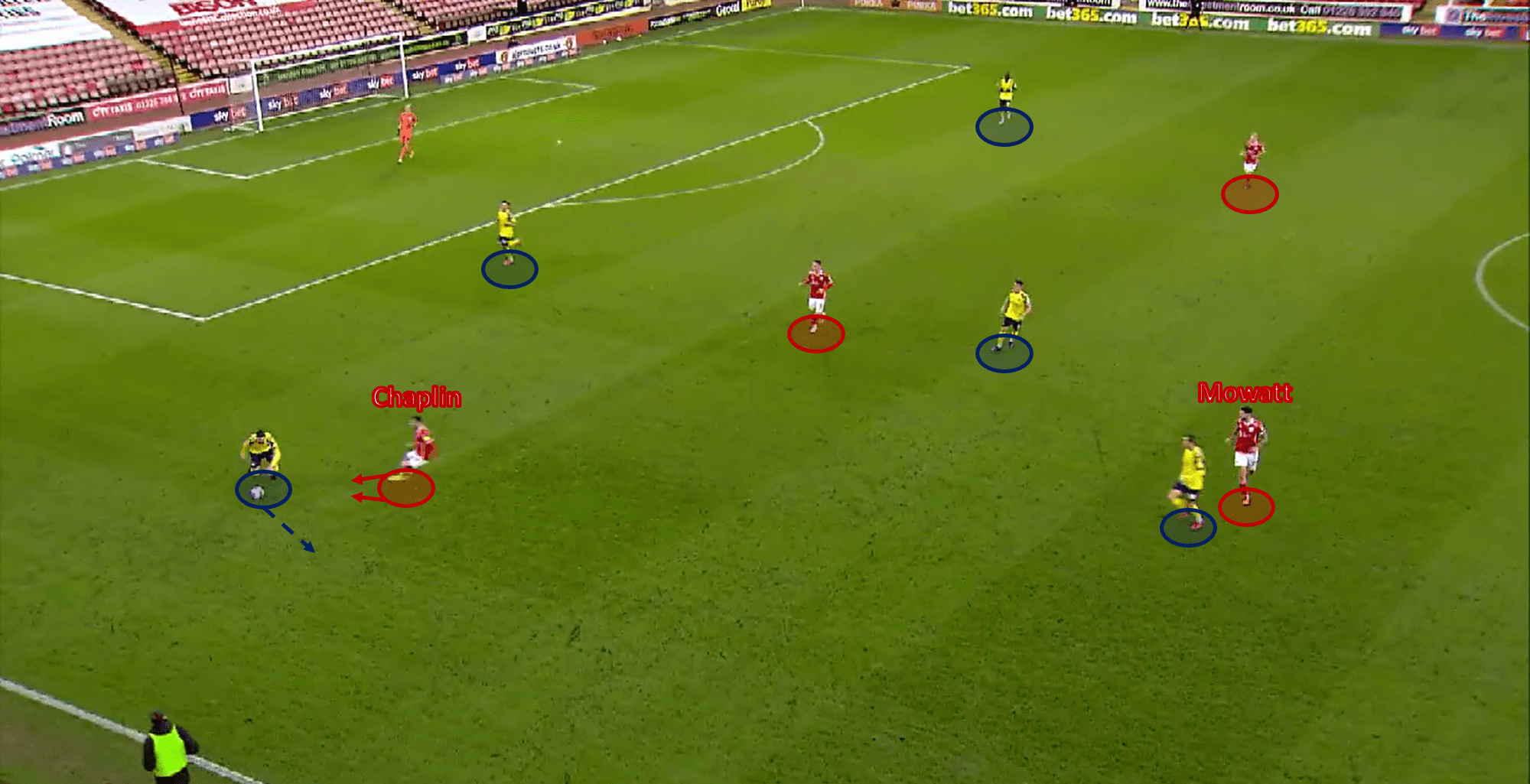
Against Huddersfield, 1-0 down, Conor Chaplin engages in a higher, aggressive press, forcing the full-back wider, cutting off central passing lanes.
In these moments, Barnsley operate with pretty aggressive high pressing tactics, 57% of their recoveries are won in medium to high zones, compared to a league average of 52% which is indicative of their high line of engagement. Ismaël has implemented a man-oriented high press, with every attacking player looking for one or two players to mark or cut off the passing avenues.
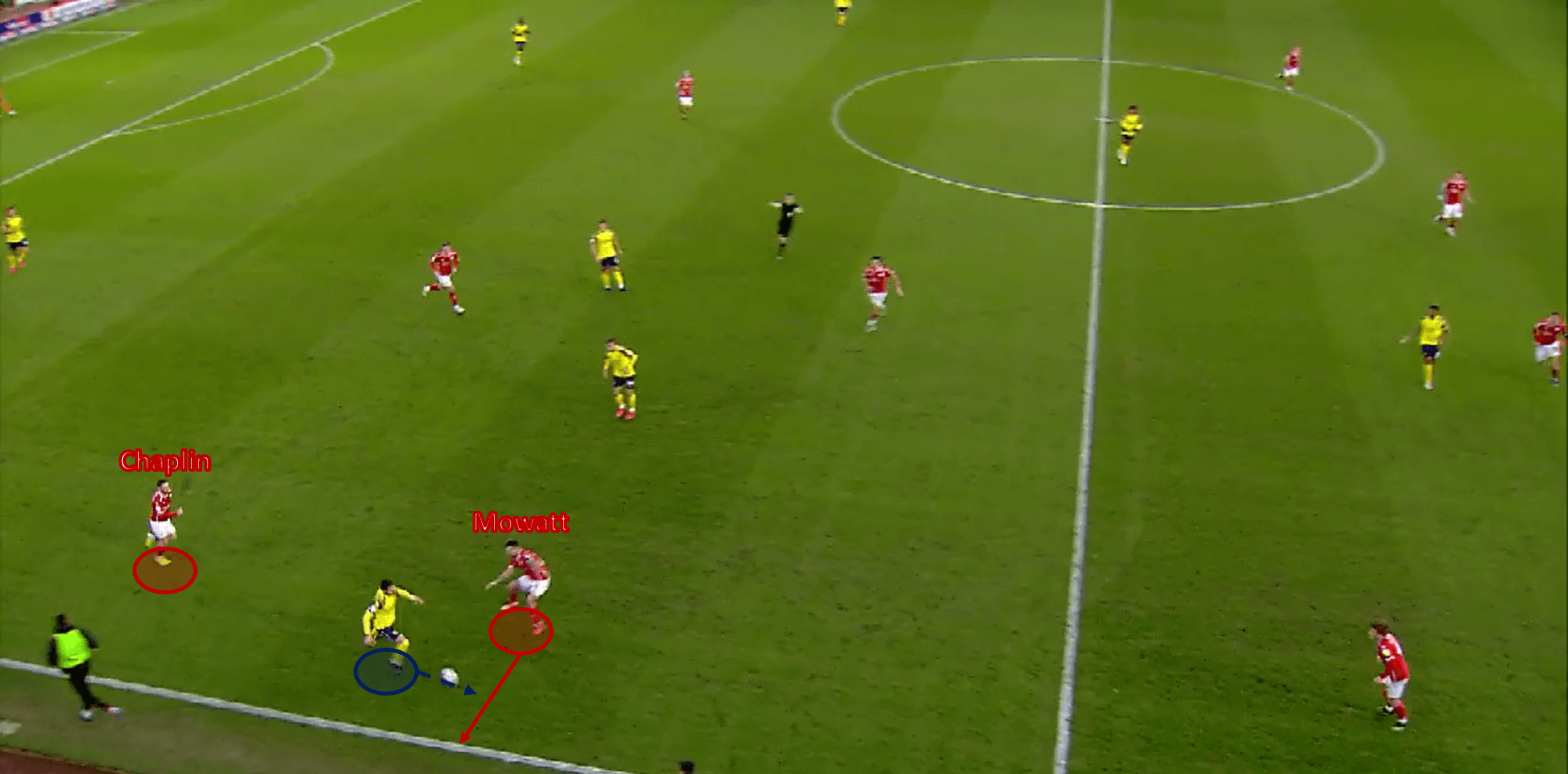
The ball bypasses Chaplin, but he is backed up by Alex Mowatt, who blocks off the opponent’s run, winning the ball back in the midfield third.
At LASK Linz, the French coach developed an effective press, and this has translated well to the Tykes. There are a couple of key differences between his two teams, one being that his Barnsley team are slightly more direct in their possession approach, and Barnsley’s midfield two are less adept in rotating the ball than Peter Michorl and James Holland were at Linz. This explains the possession drop from 56% at Linz to 46% at Barnsley.
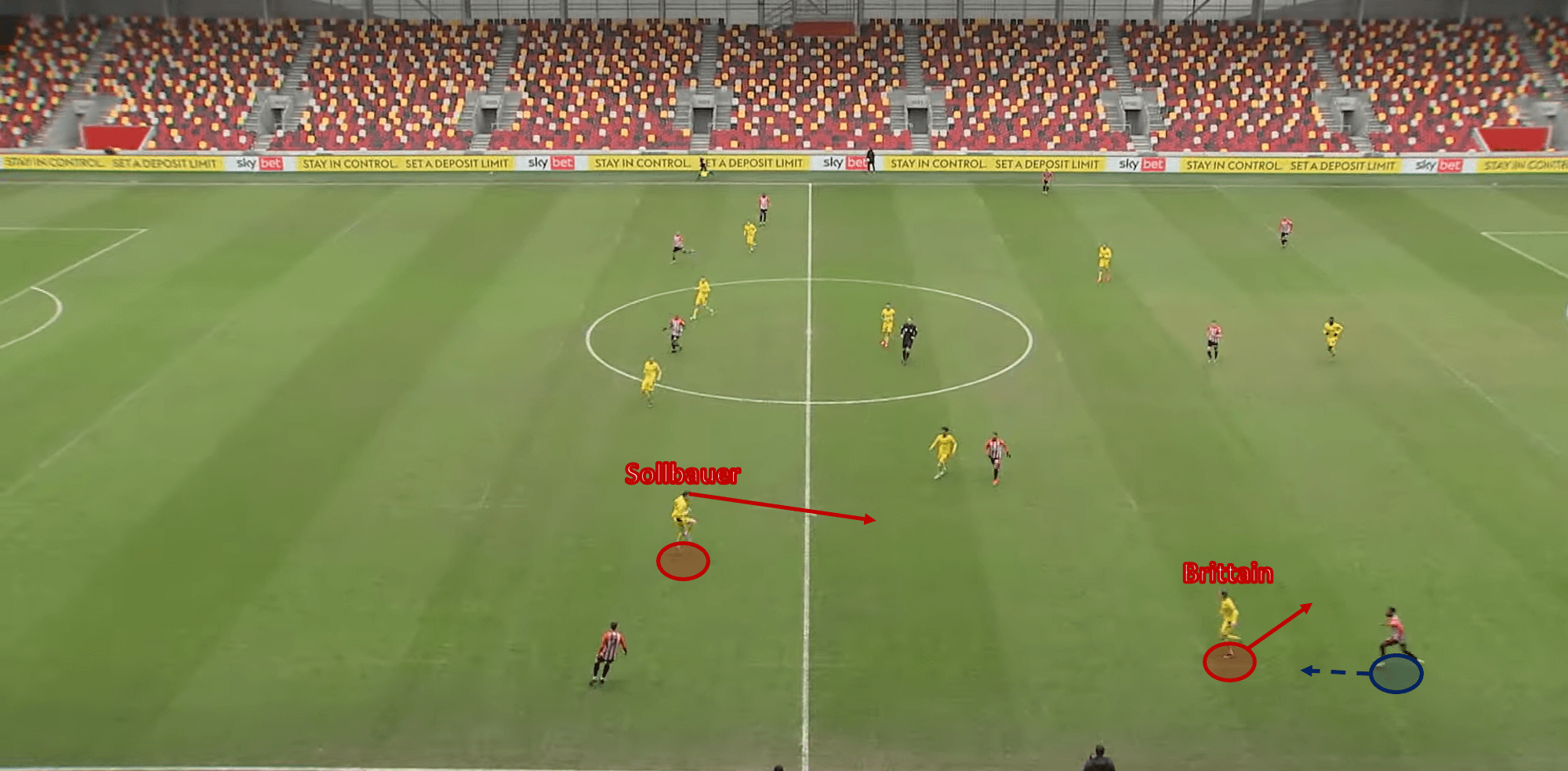
Brentford play the ball out long, met by Michael Sollbauer, who knocks it on towards Callum Brittain, and he plays the one-touch pass towards Daryl Dike.
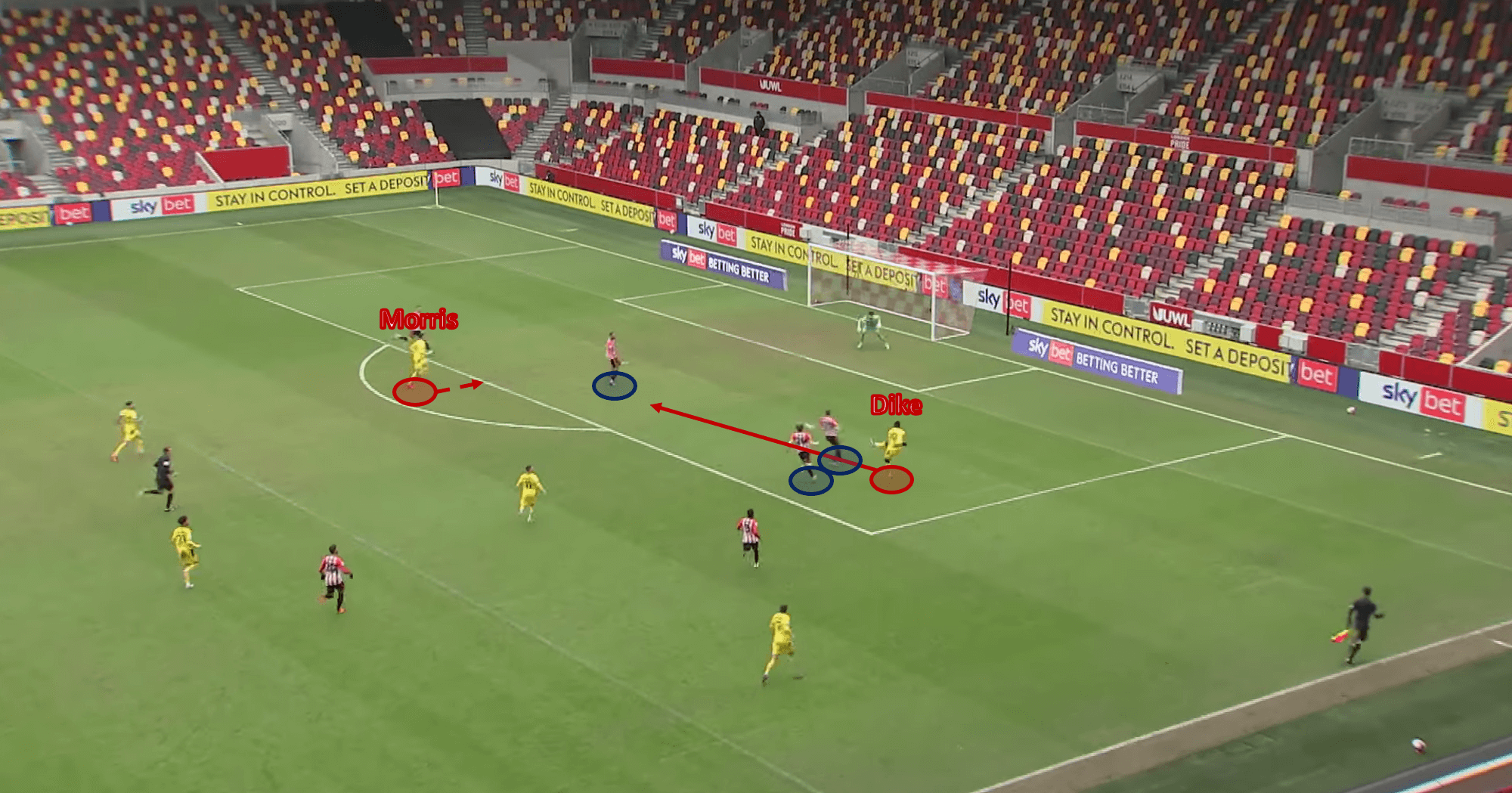
Dike drives with the ball into the penalty area and lays it off towards Carlton Morris, who dispatches it calmly.
Especially in a losing game state, Barnsley look to win back the ball as close to the opposition area as possible. The further that the opposition play through the press, the less aggressive that Barnsley become. Once their first layer of press is bypassed, the wing-backs will drop back to form a back five, and with two midfielders shuttling in front of the penalty area, Barnsley become very difficult to break down.
Although, of course, this is not always effective. Such an aggressive, high press can be exploited on the counter if Barnsley push too many players forward. This is especially the case with Barnsley’s wing-backs, who look to operate high and wide in possession, but Callum Brittain and Callum Styles can lack the sufficient recovery pace to track back and cover the gaps they have left on the counterattack.
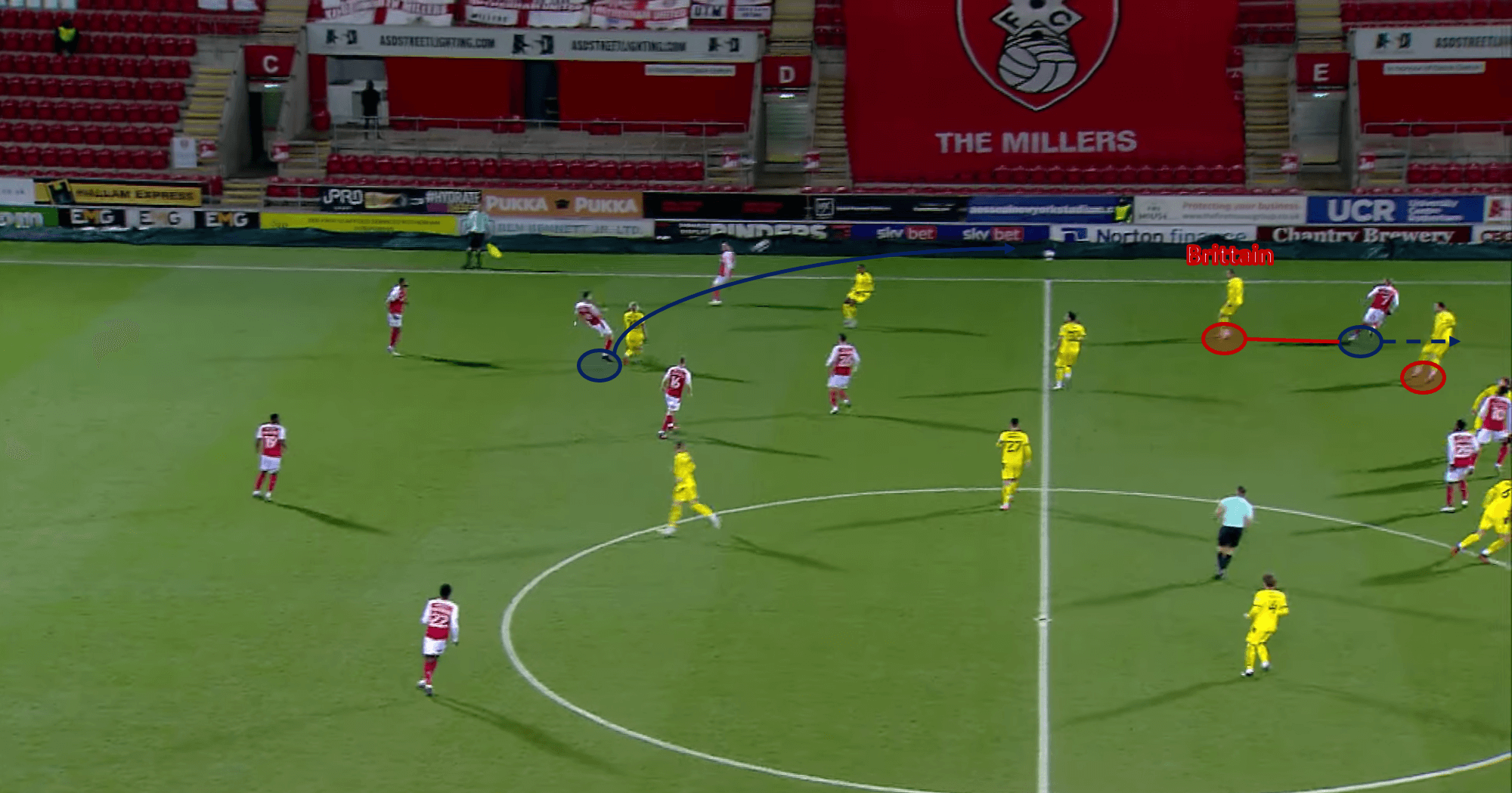
Against Rotheram, Brittain has moved up with the midfield, as Barnsley progress the ball, but Rotheram recover the ball and play the direct ball over the top against a now back three.
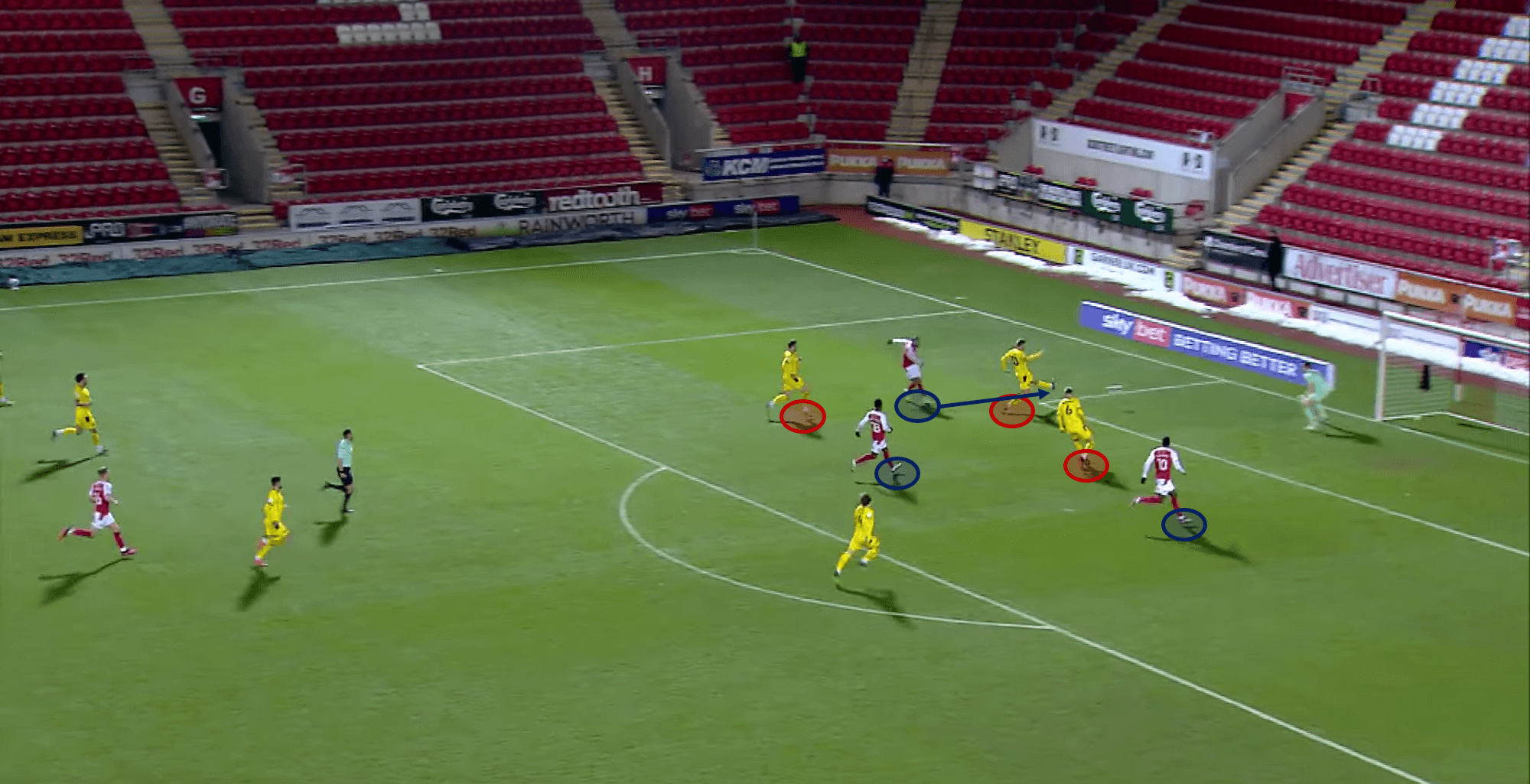
Inside the box, Barnsley are now exposed in a 3v3, where, if the Rotherham player maintains composure, could drag players to his location and lay off to a teammate in space to score.
This can leave Barnsley vulnerable, and it is how they have conceded a good proportion of their goals. In all fairness, in Ismaël’s system, the wing-back roles are the most demanding both physically and tactically, and with time, these two players should learn when or when not to make bursting forward runs. This explains why Barnsley’s back three contend for 23.5 aerial duels between them per game.
Barnsley’s ever-present wing-backs
In their 3-4-3 system, the wing-backs for Barnsley are vital for their tactics. Of course, primarily, they are the only two players to provide true width in the formation, as they will constantly stick to wide areas. Besides this, they have the role of creating triangles with the closest central midfielder and forward, to progress the ball higher up the pitch, and into the final third.
Ismaël instructs his wingers to create space for the wing-backs. Firstly, the wingers will operate within the half-space, to then make a diagonal darting run into more central areas, to drag the opposition to their location. Ahead of time, the wing-back, positioned deeper, will loom behind the wingers in these moments, and dash into the space created when the time is right.
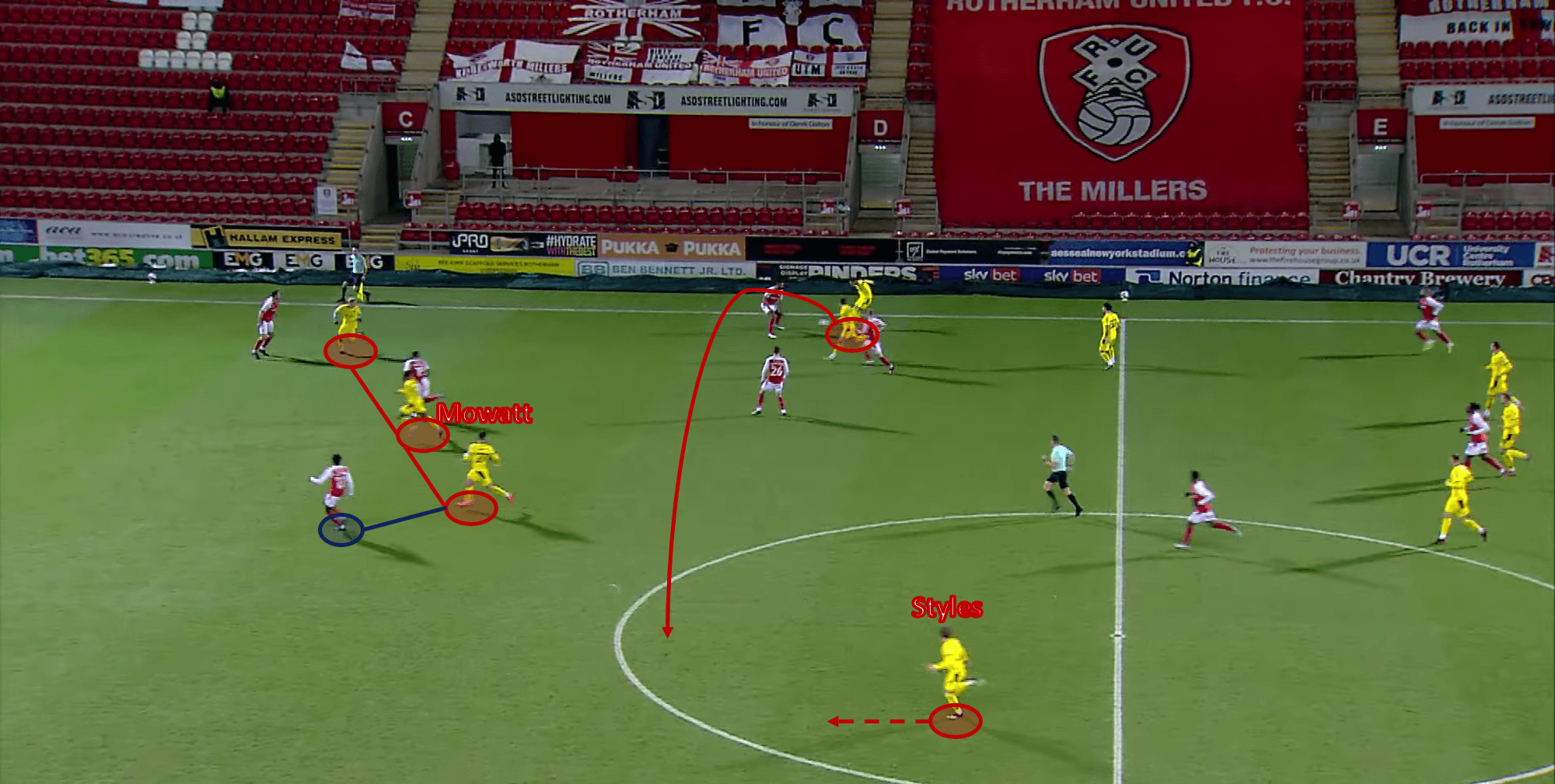
The ball is sprayed over from the right flank. Styles has acres of green grass to run into, thanks to Mowatt dragging the Rotheram defender out of position.
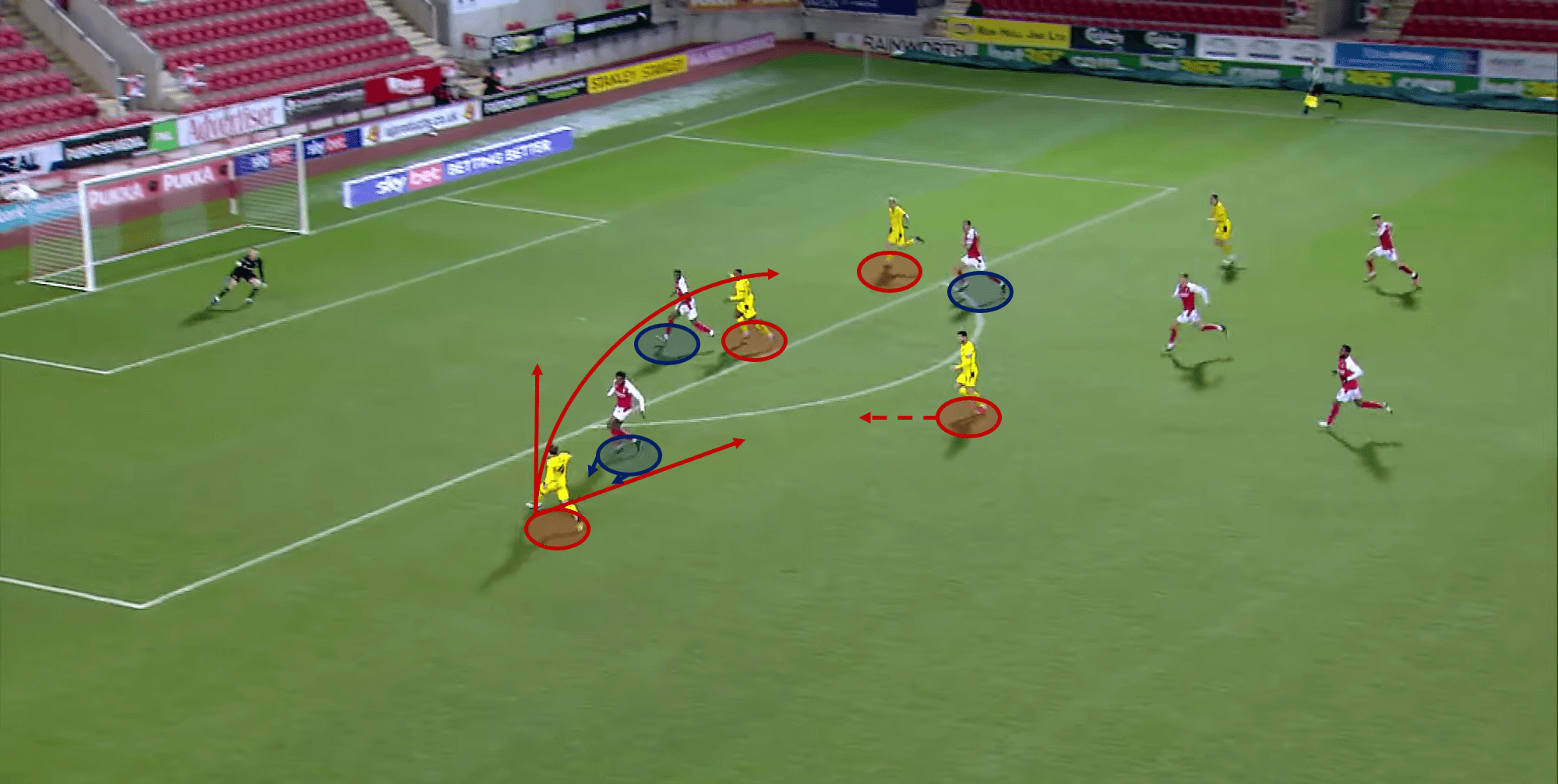
Look at this 4v3 scenario. Styles has a few passing options, but he opts for Mowatt on the edge of the area, who dispatches of his effort into the bottom corner.
When the ball is played into the box, the front three stick tight to each other, with the aim of each three of them operating within the penalty area. In these cases, the opposition defence is ultimately forced to become far more compact, attempting to mark each player out of the game, which can be difficult for team’s using a back four to pull off. Meanwhile, this creates one-on-one scenarios for the wing-backs against the opposition full-backs.
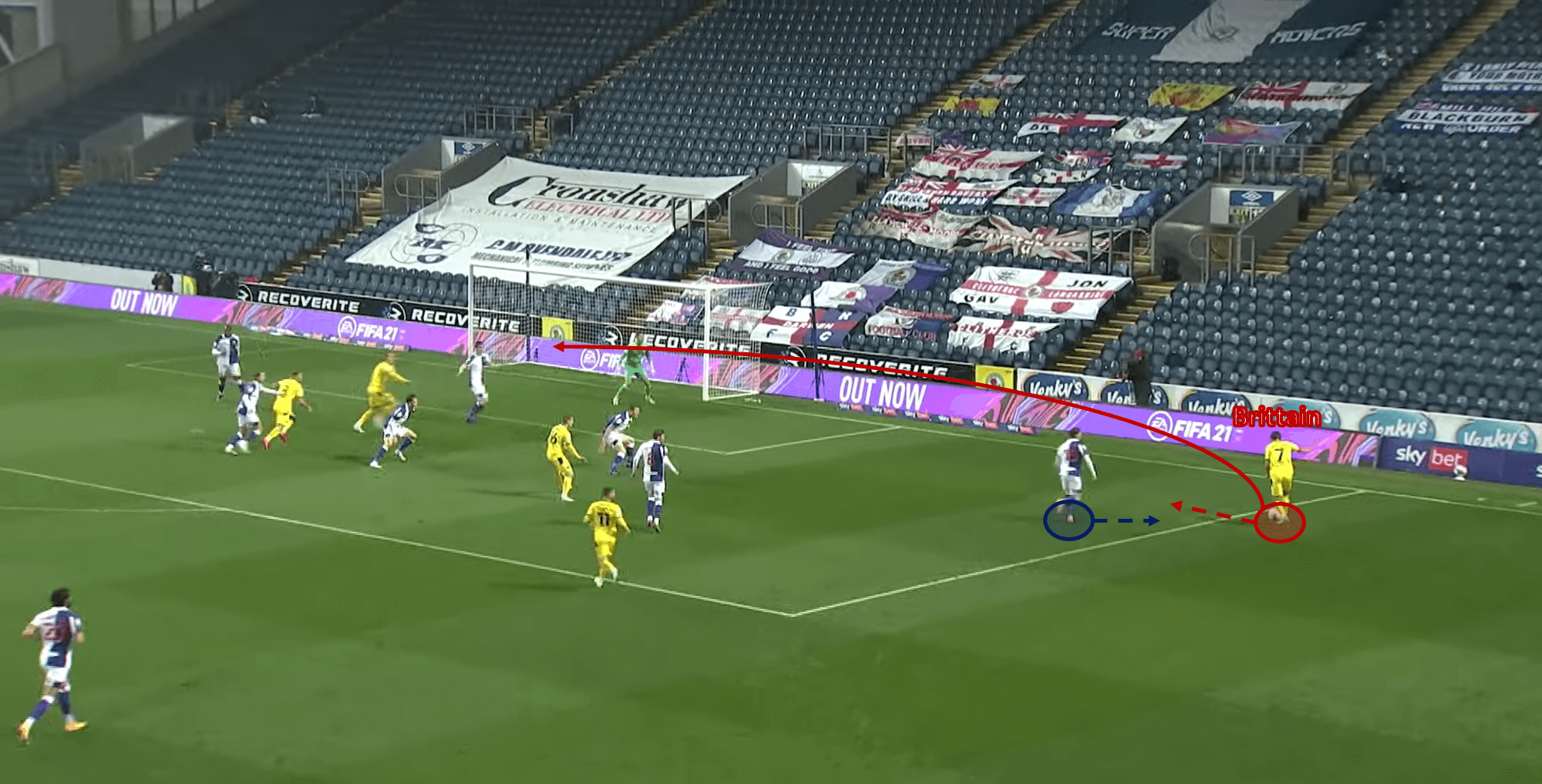
Brittain drives towards the byline and then has the option to carry the ball into the penalty area or whip the first-time delivery into the box.
Out of the two wing-backs at Barnsley, Brittain is the far more direct operator, who is more than happy to take on 1v1 scenarios head-on. This explains his 1.9 completed dribbles per game in comparison with Callum Styles’ 0.9. Although, it should be noted that Barnsley do play through the right side of the pitch far more often than the left – 41% of their attacks come down the right flank, the 6th highest proportion in the division.
Now, although the forwards regularly create space for the wing-backs to exploit in wide areas, this also works oppositely too, where the wing-backs will create space for the wingers. When the central-midfielders stay deeper, the wing-backs have the freedom to start counter-pressing high up the pitch and position themselves within the forward line, forming a band of five upfront.
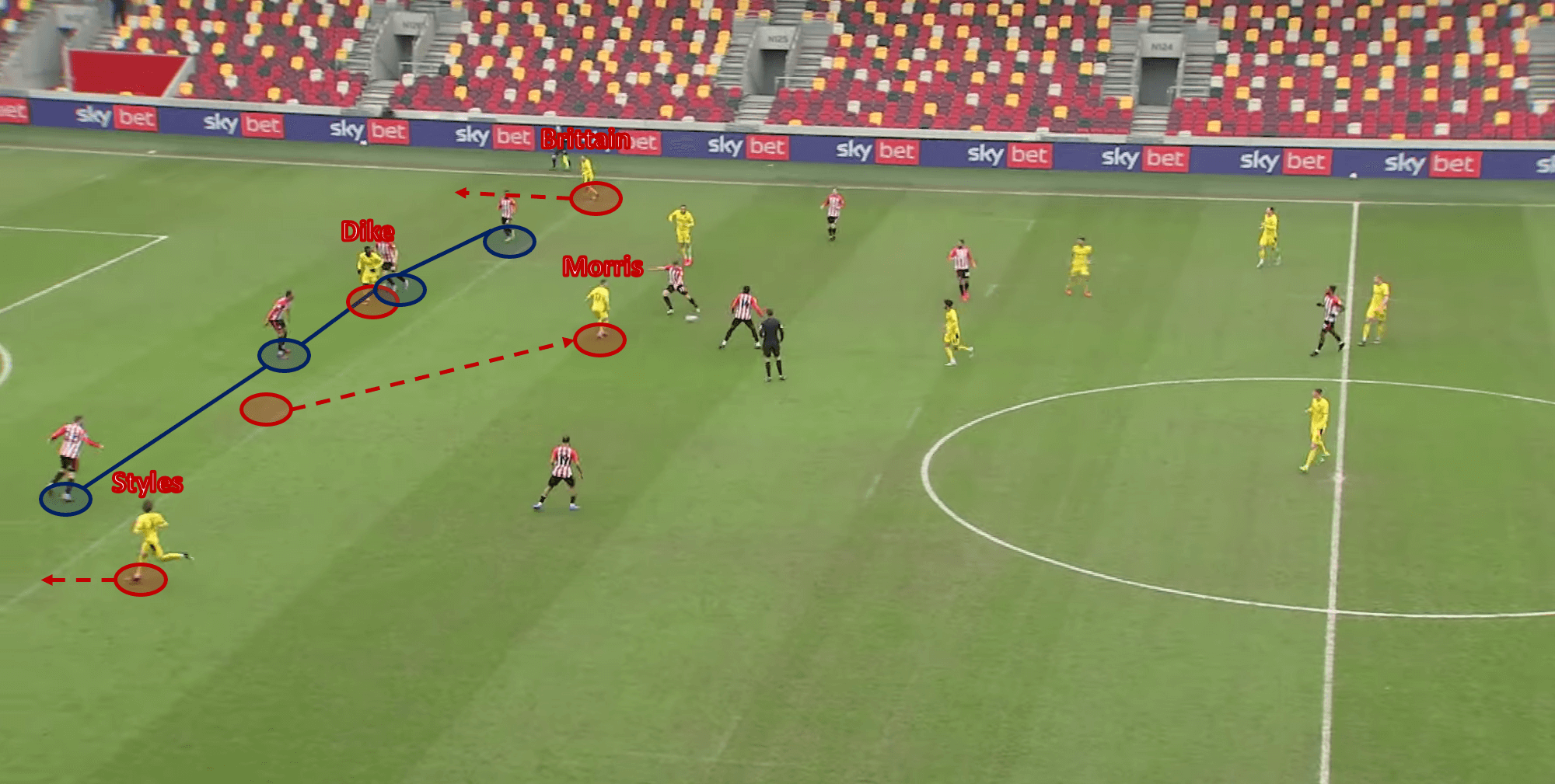
Here, we can see Morris drop deeper to collect the ball, while Styles and Brittain stay high and wide while Barnsley are in possession.
This pattern of play can often be used to overload one side of the pitch and create space over on the other side. The deeper central midfielders on the ball will have many more passing options in the final third to pick from as well, making it easier to pick out the player in the most dangerous zones. Unless playing against a team with a low defensive block, this can be extraordinarily hard for the opposition to defend against.
Barnsley’s rotations in possession
Outside of these moments where Barnsley look to exploit the wide areas, Ismaël has set out his side as a more compact 3-4-3 than what many might expect, depending on the teams they come up against. Against the better sides in the division, they will set up in a low block of five, with two midfielders shuttling in front of the penalty area, to prevent penetration through the centre of the pitch, where the highest-quality chances can be created.
When up against higher quality opposition, Barnsley are happy to let their opponents have the lion’s share of possession, and they will limit their pressing to the opposition midfielders and full-backs/wing-backs. The centre-backs are typically allowed ample time on the ball, and then as soon as the ball reaches the midfield, the press is turned on, and due to Barnsley’s compact nature, 2v1s or even 3v1s are created.
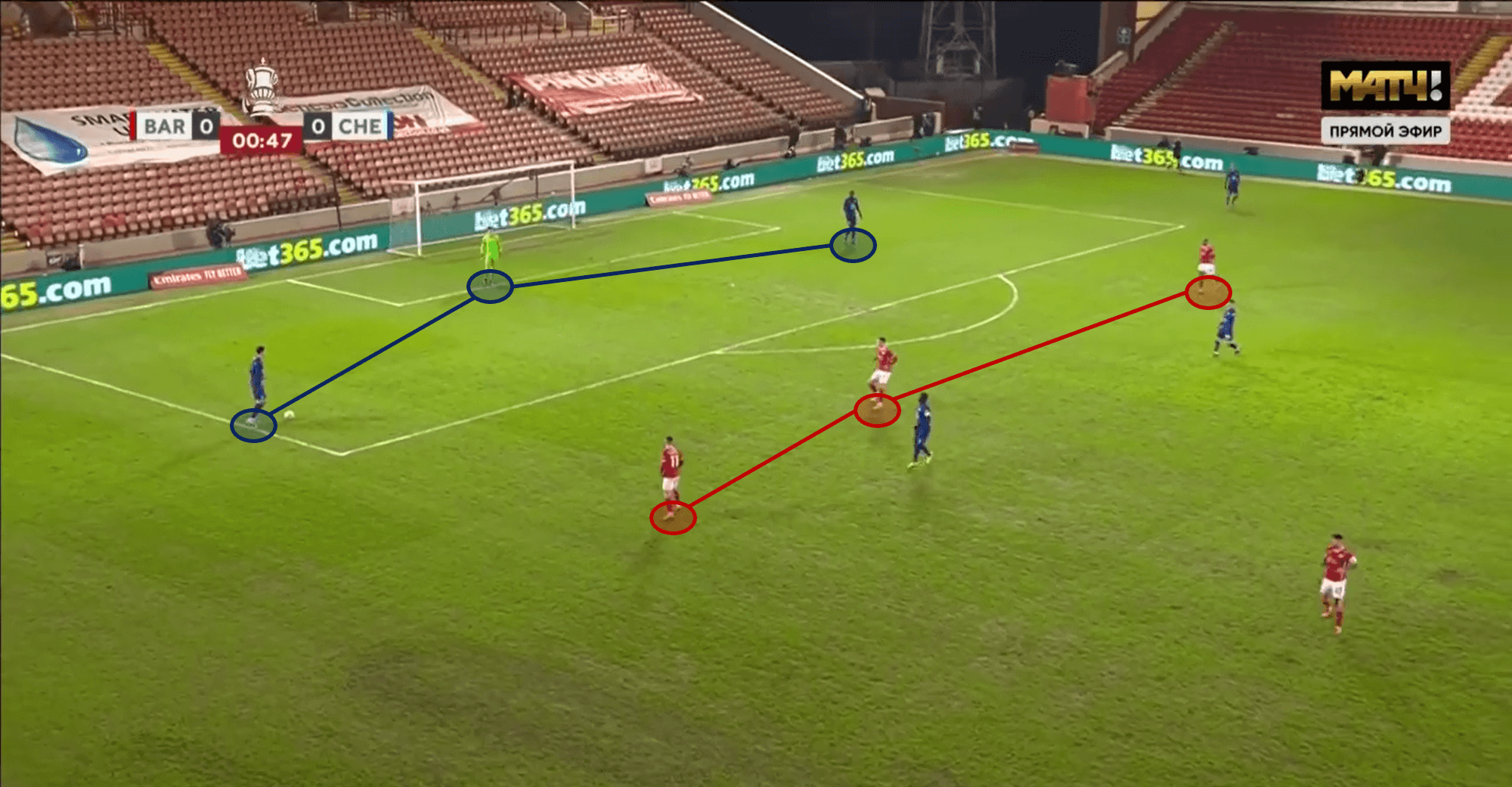
Against Chelsea, we saw Barnsley’s front three hold their line and did not engage in pressing against the Chelsea centre-backs or goalkeeper, though they would turn up the intensity versus the wing-backs.
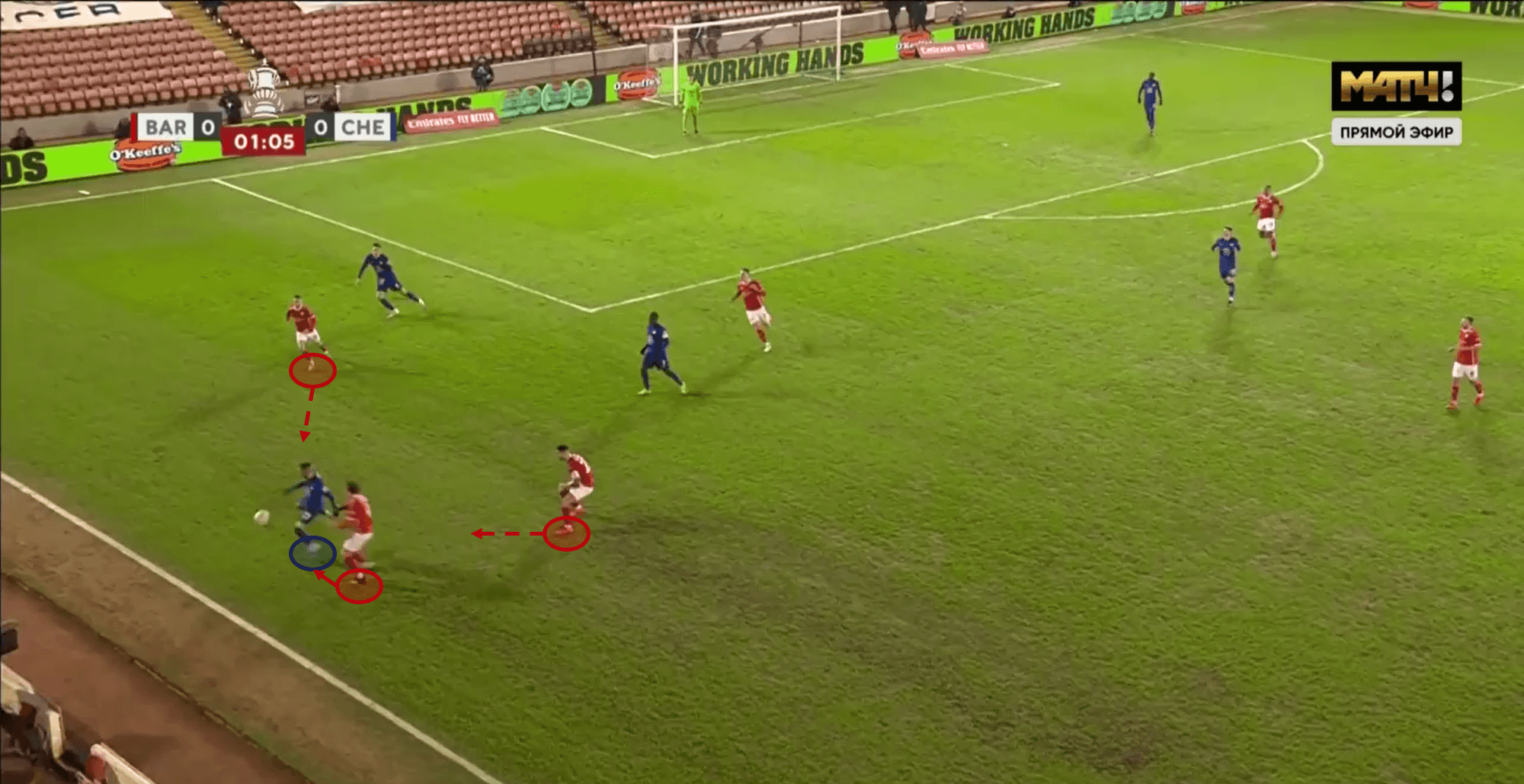
Hakim Ziyech receives the ball out wide and Barnsley have two players tracking the Moroccan down, with Chaplin higher up ready to receive and turn with the ball.
Once the ball is recovered, Barnsley can then attack at speed, with overloads created in central areas, given that the ball has been retrieved off of an opposition central midfielder. In these moments where the ball is won back, Barnsley can attack with a band of five forwards, where the two wing-backs join the attacking unit, and the two central midfielders stay deeper to link up play and help defend against potential counterattacks.
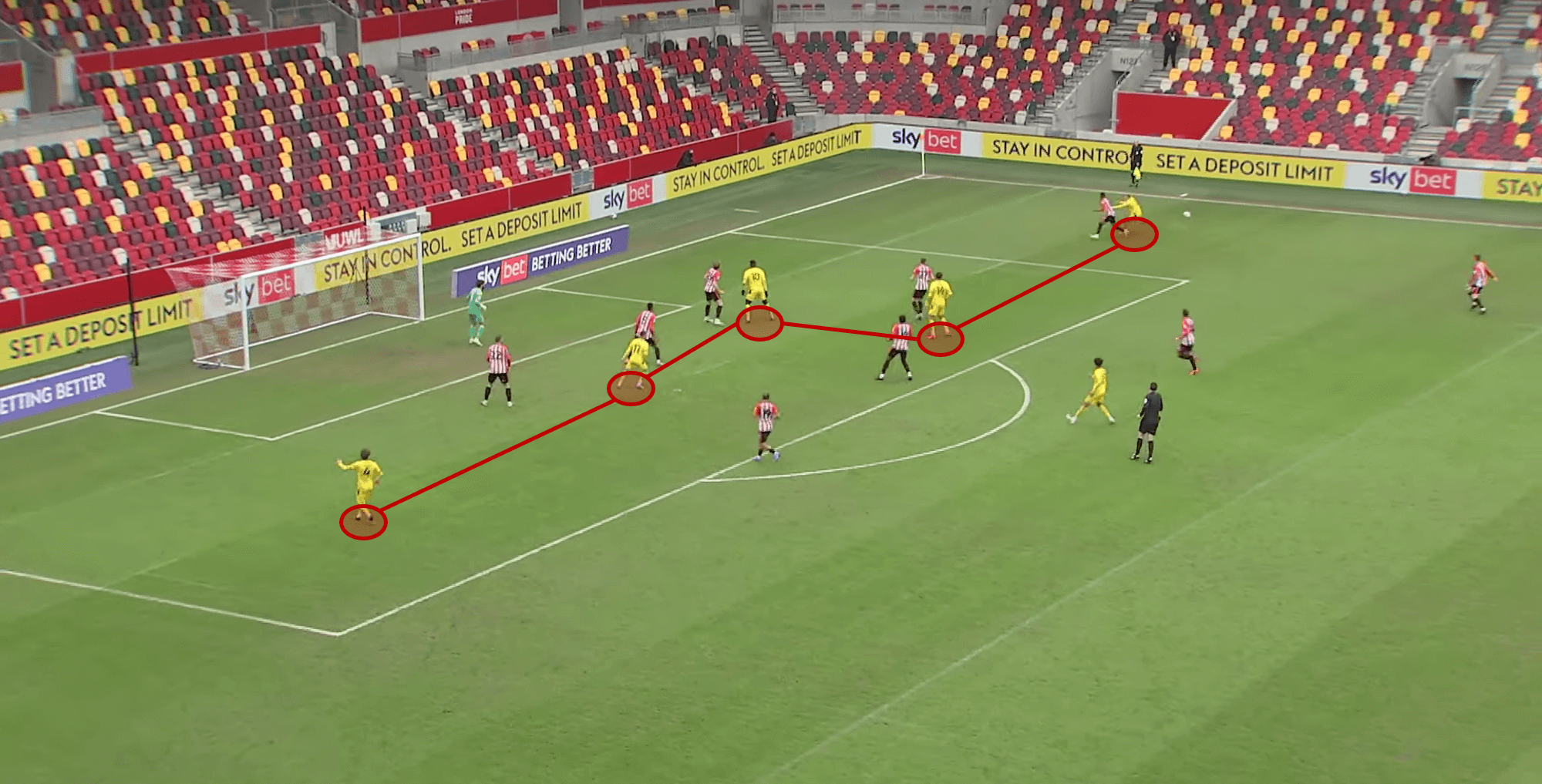
Barnsley’s band of five attacking players, with two high and wide wing-backs, and three forwards who stick close to one another inside the area.
Although, when Barnsley start to get countered down one side of the pitch, Ismaël is quite good at tweaking his tactics to suit. If we see their left flank exploited on the break a couple of times, the French coach will instruct Styles to drop deeper in attacking scenarios to prevent this. This leaves space for one of the central-midfielders (typically captain Mowatt) to make late bursting runs, pick up the ball on the edge of the area, and shoot.
The club captain’s return of five goals and four assists in the league is evidence of how fruitful these endeavours can be, and he is quite clever in the timing of these runs, as to not be exposed on the counter. Mowatt is also key in the build-up (completing the most passes in the squad per game) – he suits Ismaël’s tactics of playing penetrating vertical passes when the option arises, while also maintaining a calm, organised build-up.
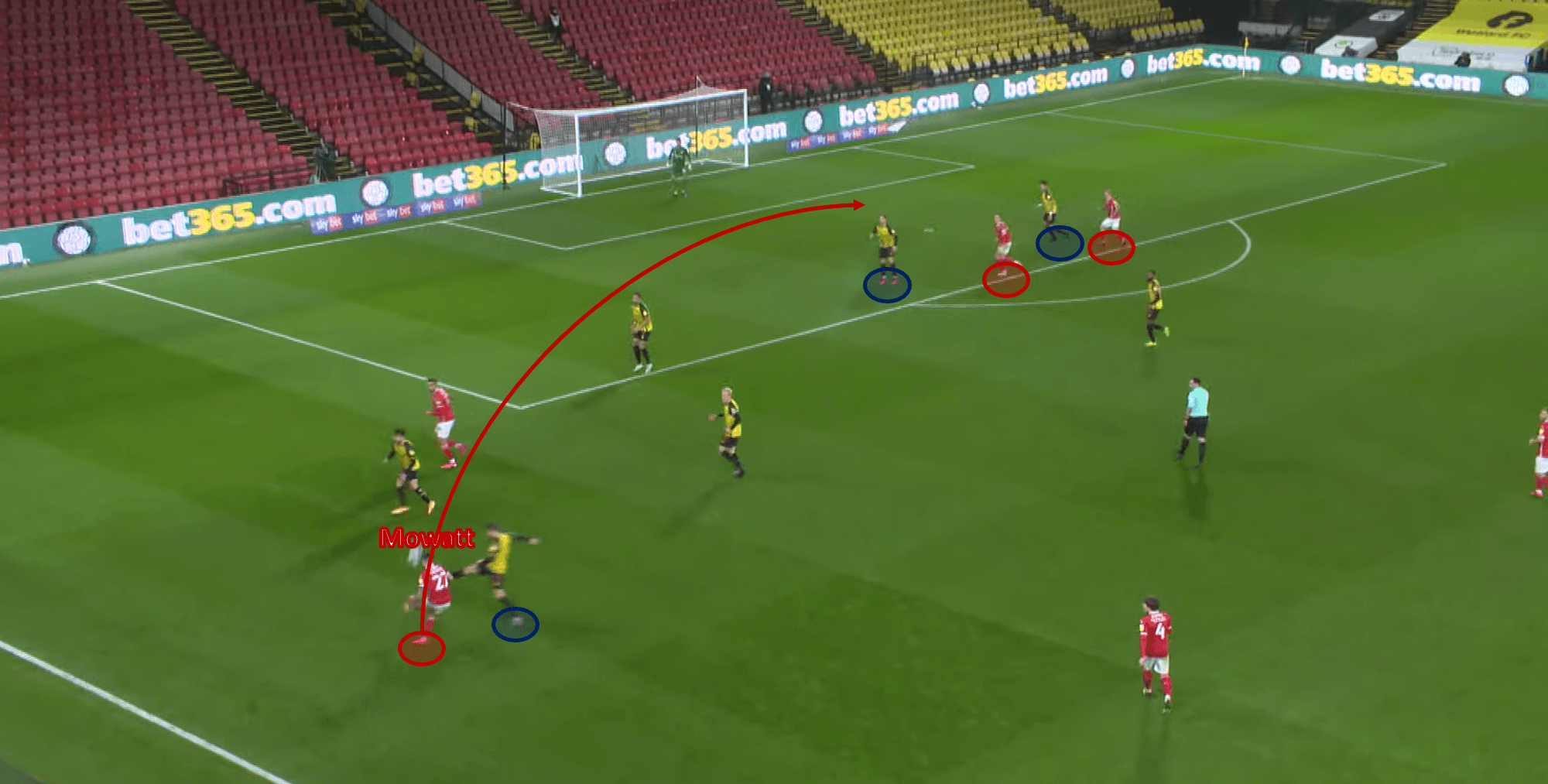
Mowatt covers the space in a wide zone, since Styles has shifted into a more central position, and the captain picks up the ball, and immediately looks for the progressive pass, playing it into the penalty area.
Ismaël’s tactics include several passing triangles; three of which are created by the back three and the two central midfielders in front. These five players aim to keep the ball until they find a way to progress the ball into the higher lines. The double-pivot in midfield is typically staggered, where one of them drops deeper to collect the ball, the other maintains a higher position, or stays deeper depending on the structure of the opposition.
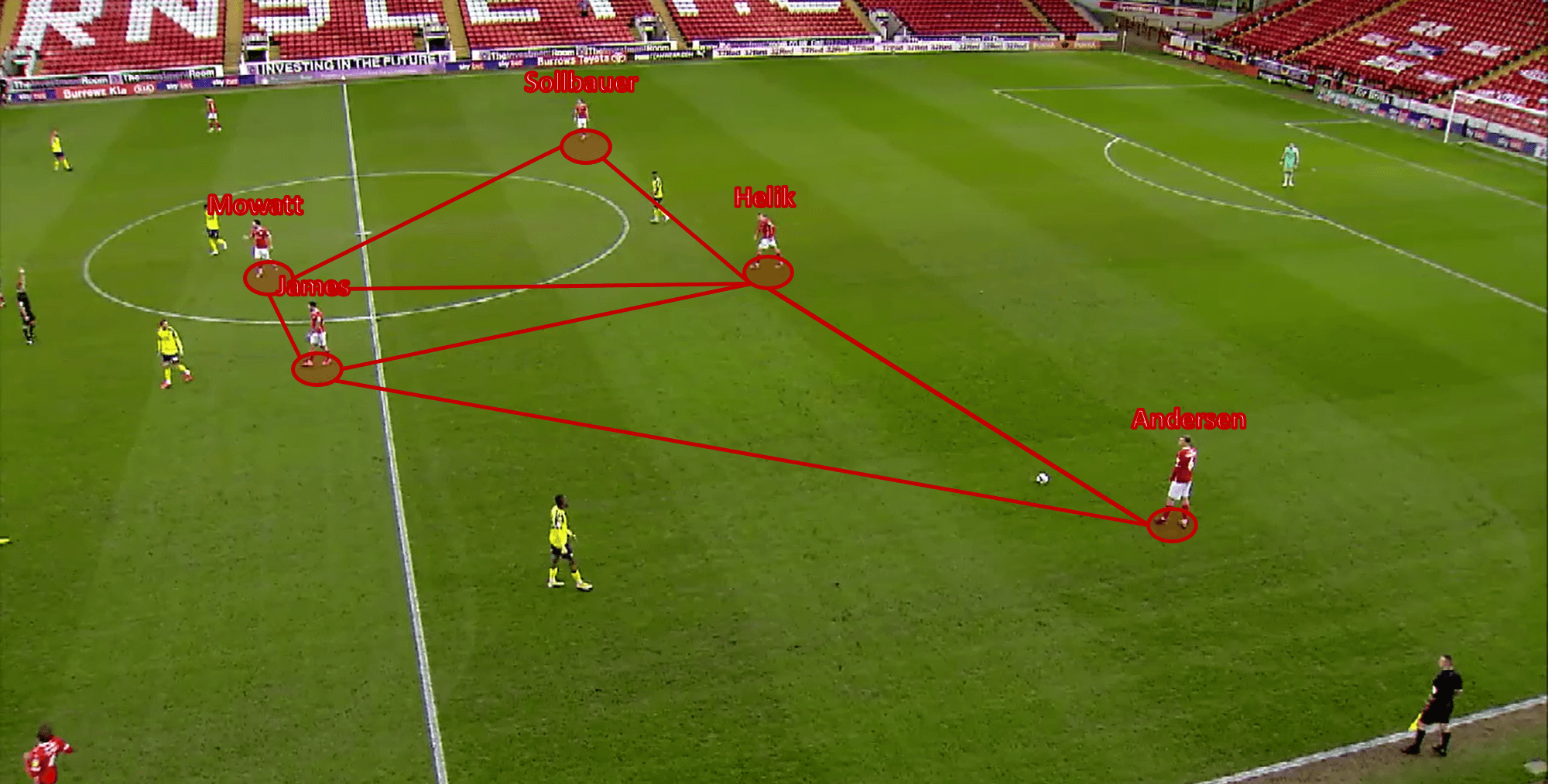
Despite this being from a set-piece, we can see visually see the foundations for Barnsley’s build-up play, with the three passing triangles.
Anyways, a brief glance at some of Barnsley’s passing statistics will come as a shock to those of you who do not watch Barnsley frequently. For example, their three centre-backs, Sollbauer, Mads Andersen, and Michal Helik, each old an average passing accuracy % of 59%, 58%, and 58% respectively. This is shockingly low for ball-playing centre-backs, and it is a mix of sometimes lacking quality on the ball and tactical instructions.
Only two teams in the Championship complete more than their 80 long balls per match, and this is for good reason. The five deepest players will look to play the ball directly into one of the forwards, and as we mentioned earlier, they tend to play compact and look to play off of each other with one-twos in the penalty area. It helps that Cauley Woodrow is a physical adept striker who can face away from goal and stay in possession.
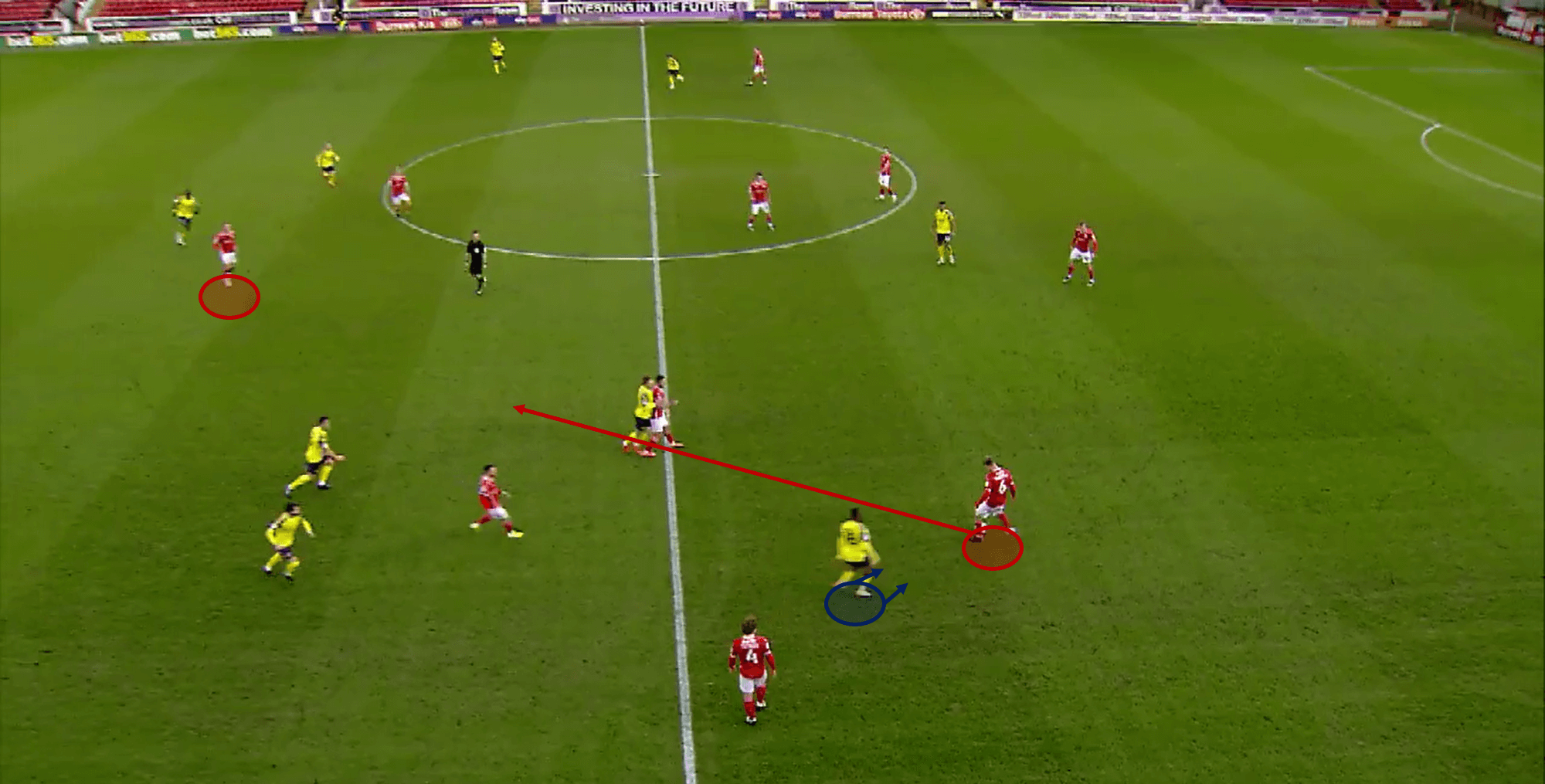
Andersen receives the ball and immediately searches for the centre-forward to play the vertical pass to.
These vertical passes are not always played off the ground, but sometimes stick to the surface when aiming for one of the highly-positioned wing-backs or wingers, who will position themselves between the lines of the opposition to create distance between themselves and the defenders. The forward line will drop back when necessary to aid ball progression, and they will not always look to run in behind and tire out the opposition defence.
Conclusion
Here is the lowdown of Ismaël’s time at Barnsley so far; he has won 12, drawn 3 and lost 8 of his 23 matches in the Championship so far, accumulating 39 points on the table. Projected across the course of an entire league season, Barnsley would earn 74 points, enough to place them 5th in the league based on last season’s rankings. A fair upgrade on their current 10th place position as of match week 29.
Ismaël has come in and instilled a winning mentality into a young Tykes team. He is an adjustable coach, who has altered his tactics even from his time in Austria with Linz. He understands the potential pitfalls of his risky tactical setup but also appreciates the massive benefit it can have on a team. It is demanding, and arguably more tactically adept than most other Championship teams, and it should be imagined that Ismaël will be courted by several Premier League clubs as we approach the business end of the season. For now, Barnsley have struck gold with an ambitious, young coach who has a bright future ahead of him.




Comments